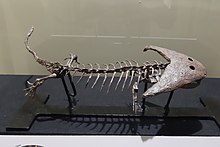
Back فقاريات رقيقة Arabic Lepospòndils Catalan Lepospondyli German Lepospondyli Esperanto Lepospondyli Spanish پوکمهرگان Persian Lepospondyli Finnish Lepospondyli French לפוספונדילים HE Lepospondyli Italian
| Lepospondyls Temporal range:
| |
|---|---|

| |
| Diplocaulus, a diplocaulid "nectridean" | |
| Scientific classification | |
| Domain: | Eukaryota |
| Kingdom: | Animalia |
| Phylum: | Chordata |
| Clade: | Sarcopterygii |
| Clade: | Tetrapodomorpha |
| Clade: | Stegocephali |
| Subclass: | †Lepospondyli Zittel, 1888 |
| Groups | |
|
Lissamphibia? | |
Lepospondyli is a diverse taxon of early tetrapods. With the exception of one late-surviving lepospondyl from the Late Permian of Morocco (Diplocaulus minimus),[4] lepospondyls lived from the Visean stage of the Early Carboniferous to the Early Permian and were geographically restricted to what is now Europe and North America.[5][2] Five major groups of lepospondyls are known: Adelospondyli; Aïstopoda; Lysorophia; Microsauria; and Nectridea. Lepospondyls have a diverse range of body forms and include species with newt-like, eel- or snake-like, and lizard-like forms. Various species were aquatic, semiaquatic, or terrestrial. None were large (the biggest genus, the diplocaulid Diplocaulus, reached a meter in length, but most were much smaller), and they are assumed to have lived in specialized ecological niches not taken by the more numerous temnospondyl amphibians that coexisted with them in the Paleozoic. Lepospondyli was named in 1888 by Karl Alfred von Zittel, who coined the name to include some tetrapods from the Paleozoic that shared some specific characteristics in the notochord and teeth. Lepospondyls have sometimes been considered to be either related or ancestral to modern amphibians[6][7][8] or to Amniota (the clade containing reptiles and mammals).[9] It has been suggested that the grouping is polyphyletic, with aïstopods being primitive stem-tetrapods, while recumbirostran microsaurs are primitive reptiles.[10]
- ^ Andrews, S.M.; Carroll, R.L. (1991). "The Order Adelospondyli: Carboniferous lepospondyl amphibians". Transactions of the Royal Society of Edinburgh: Earth Sciences. 82 (3): 239–275. doi:10.1017/s0263593300005332. S2CID 84460890.
- ^ a b Marjanović, D. (2021). "The Making of Calibration Sausage Exemplified by Recalibrating the Transcriptomic Timetree of Jawed Vertebrates". Frontiers in Genetics. 12. 521693. doi:10.3389/fgene.2021.521693. PMC 8149952. PMID 34054911.
- ^ Cite error: The named reference
R&C07was invoked but never defined (see the help page). - ^ Germain, D (2010). "The Moroccan diplocaulid: the last lepospondyl, the single one on Gondwana". Historical Biology. 122 (1–3): 4–39. doi:10.1080/08912961003779678. S2CID 128605530.
- ^ Carroll, R. L. (1988) Vertebrate Paleontology and Evolution, WH Freeman & Co.
- ^ Vallin, G; Laurin, M (2004). "Cranial morphology and affinities of Microbrachis, and a reappraisal of the phylogeny and lifestyle of the first amphibians". Journal of Vertebrate Paleontology. 24: 56–72. doi:10.1671/5.1. S2CID 26700362.
- ^ Marjanović, D.; Laurin, M. (2009). "The origin(s) of modern amphibians: a commentary" (PDF). Evolutionary Biology. 36 (3): 336–338. doi:10.1007/s11692-009-9065-8. S2CID 12023942.
- ^ Marjanović, D; Laurin, M (2013). "The origin(s) of extant amphibians: a review with emphasis on the "lepospondyl hypothesis"". Geodiversitas. 35: 207–272. doi:10.5252/g2013n1a8. S2CID 67823991.
- ^ Cite error: The named reference
RCQ03was invoked but never defined (see the help page). - ^ Jason D. Pardo, Matt Szostakiwskyj, Per E. Ahlberg & Jason S. Anderson (2017) Hidden morphological diversity among early tetrapods. Nature (advance online publication) doi:10.1038/nature22966>
© MMXXIII Rich X Search. We shall prevail. All rights reserved. Rich X Search